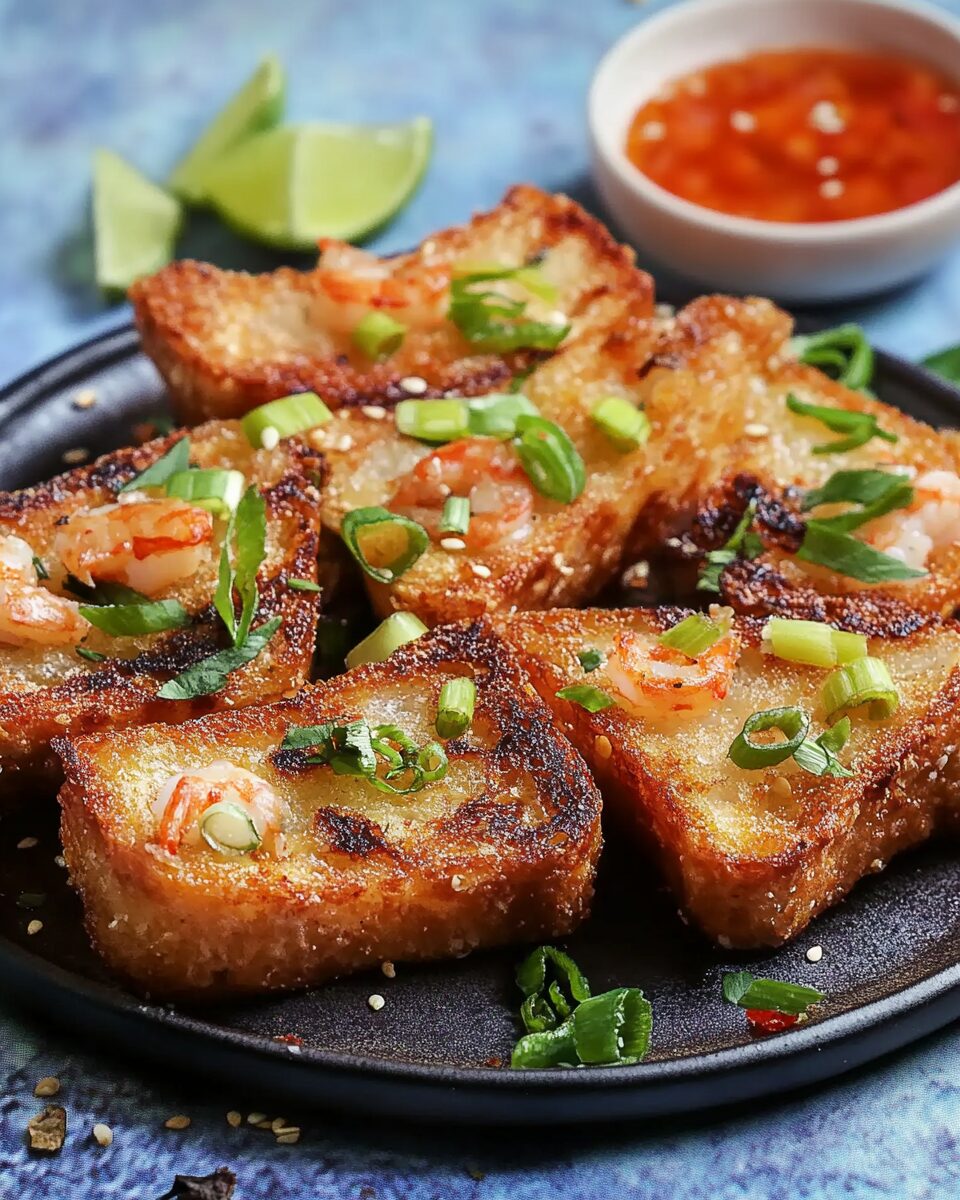Chinese Prawn Toast, also known as sesame prawn toast, is a popular appetizer in Chinese cuisine. It consists of small triangles of bread topped with a flavorful prawn mixture, coated in sesame seeds, and fried until golden and crispy. This dish combines the sweetness of prawns with the crunch of toasted sesame seeds, making it a favorite in many households and restaurants.
Full Recipe:
Ingredients
- 200g raw prawns, peeled and deveined
- 1 clove garlic, roughly chopped
- 1 teaspoon finely grated ginger
- 1 egg white
- 1 teaspoon light soy sauce
- 2 spring onions, very finely chopped
- 3 slices white bread, crusts removed
- 100g sesame seeds
- Vegetable oil, for shallow frying
Directions
- Using a food processor, blend the prawns, garlic, ginger, egg white, soy sauce, and spring onions until a smooth paste forms.
- Cut each slice of bread into four triangles.
- Spread a generous layer of the prawn mixture on the non-crust side of each bread triangle.
- Place the sesame seeds on a plate and press the prawn-covered side of each triangle into the seeds, ensuring an even coating.
- Heat vegetable oil in a frying pan over medium heat.
- Fry the bread triangles, prawn side down, until the sesame seeds are golden brown.
- Flip and fry the other side until golden.
- Drain on paper towels and serve immediately.
Nutritional Facts
- Calories: Approximately 360 kcal per serving
- Protein: 20g
- Carbohydrates: 30g
- Fat: 20g
- Fiber: 2g
- Sodium: 600mg
The Origin of Prawn Toast
The exact origins of prawn toast remain somewhat uncertain, with many suggesting it was first introduced to China in the early 20th century as part of a modernization of Chinese cooking. One common theory is that prawn toast emerged in Shanghai, where chefs sought to create a dish that combined the rich flavors of shrimp with the Western influence of bread. Prawn toast may have been a result of adapting local ingredients to the evolving tastes and techniques of the time.
Others believe that prawn toast has roots in the culinary traditions of Guangdong province, which is known for its seafood and Cantonese-style cooking. Guangdong cuisine has long incorporated the technique of grinding seafood and mixing it with ingredients like soy sauce, garlic, and spices to create pastes that can be spread on various types of bread or crackers, which would give rise to the prawn toast recipe.
Regardless of its exact origin, one thing is certain – prawn toast quickly became a popular dish in Chinese restaurants, particularly in Hong Kong, where it became a favorite part of dim sum menus. Today, prawn toast is a signature dish in many Chinese eateries around the world, including in Western countries, where it is often enjoyed as part of Chinese takeout or in specialty restaurants serving Chinese-inspired tapas.
The Ingredients and Preparation Process
While the ingredient list for prawn toast is relatively simple, the magic of the dish lies in how these ingredients come together. The key components of prawn toast are prawns, bread, sesame seeds, and oil. The prawns are typically minced into a smooth paste, often combined with garlic, ginger, spring onions, and a touch of soy sauce to enhance the flavor. This mixture is then spread onto slices of white bread that have had their crusts removed. The bread is then dipped in sesame seeds, giving it a beautiful coating that crisps up during frying.
The preparation process, though straightforward, requires careful attention to ensure that the prawns are seasoned correctly, the bread is coated evenly with the sesame seeds, and the frying process yields the perfect level of crispness without overcooking. The bread should be crisp on the outside, while the prawn paste inside remains tender and flavorful. Achieving this balance is what makes prawn toast a truly enjoyable dish.
Traditionally, prawn toast is shallow fried, though it can also be deep-fried for a crunchier result. The oil should be heated to the right temperature so that the bread crisps up quickly, sealing in the prawn mixture and preventing it from spilling out. Once fried, the prawn toast is drained on paper towels to remove excess oil, and it is served hot, often garnished with a dipping sauce or accompanied by other dim sum items.
Cultural Significance of Prawn Toast
Prawn toast is not only a dish with a unique and appealing flavor, but it also carries cultural significance in Chinese cuisine. Like many traditional Chinese foods, prawn toast is associated with celebrations and communal dining. Dim sum, a style of Cantonese cuisine where small dishes are served in a social setting, often includes prawn toast on its menu, making it a popular choice for gatherings, banquets, and family meals.
In Chinese culture, food plays a vital role in celebrations, and each dish often carries symbolic meaning. Prawn toast, with its rich prawn filling and crispy exterior, can symbolize wealth and abundance. Seafood, in particular, is often associated with good fortune, and prawns are believed to represent happiness and prosperity. The golden-brown color of the toasted bread, combined with the vibrant white filling, may also symbolize good luck and happiness.
The dish’s popularity during festive occasions, such as Chinese New Year, further emphasizes the importance of food in celebrating family, friendship, and prosperity. Prawn toast, like many Chinese dishes, has evolved to be enjoyed during both casual and formal occasions. Its versatility, quick preparation, and rich taste make it an excellent addition to any meal.
Modern Variations of Prawn Toast
Though the traditional method of preparing prawn toast is still widely used, modern adaptations have emerged, particularly in Western countries where the dish is often served as part of Chinese-inspired tapas or as an appetizer in fusion restaurants. These variations may incorporate different types of bread, such as whole wheat or sourdough, to add a unique twist to the texture and flavor. Additionally, some versions of prawn toast may feature other seafood, like crab or scallops, mixed with prawns, creating a richer and more complex filling.
In some restaurants, prawn toast is given a contemporary upgrade with inventive toppings or garnishes, such as chili sauce, sweet chili glaze, or fresh herbs like cilantro. Other variations may include a more substantial portion of filling, making the prawn toast larger or thicker. Additionally, some chefs have adapted the recipe for healthier diets, opting for air frying instead of deep frying to reduce the amount of oil used in the preparation.
The dish’s popularity continues to grow, and chefs around the world are constantly finding new ways to give prawn toast a modern spin while preserving its essential elements. Whether served as a small appetizer or a more substantial main course, prawn toast remains a dish that can easily be adapted to various tastes and preferences.
Nutritional Benefits of Prawn Toast
While prawn toast is undeniably delicious, it’s important to consider its nutritional value, especially if it’s a frequent part of your diet. The primary ingredients in prawn toast – prawns, bread, and sesame seeds – offer several nutritional benefits. Prawns, a lean source of protein, are rich in essential nutrients such as omega-3 fatty acids, vitamins B12, and minerals like zinc and iodine. They are also low in fat, making them a great choice for those looking to increase their protein intake without adding excess calories.
Bread, particularly white bread, is primarily composed of carbohydrates, which provide energy. While white bread may not be as nutrient-dense as whole wheat bread, it still contributes to a balanced diet when eaten in moderation. The sesame seeds used to coat the bread add healthy fats, including polyunsaturated fats, which are beneficial for heart health. They are also a source of essential minerals like calcium, magnesium, and iron.
However, it’s important to note that the frying process can add significant amounts of oil, increasing the calorie count and fat content of the dish. While shallow frying is generally considered a healthier option than deep frying, the overall calorie content of prawn toast can still be relatively high, especially if consumed in large quantities. For those looking to reduce their calorie intake, a healthier alternative is to bake the prawn toast instead of frying it. This will still result in a delicious, crispy texture but with less oil.
When enjoyed in moderation, prawn toast can be a satisfying and nutrient-dense appetizer or snack, providing a good balance of protein, healthy fats, and essential vitamins and minerals. It’s best served as part of a balanced meal, accompanied by fresh vegetables or other light dishes to ensure that the overall nutritional content remains well-rounded.
Conclusion
Chinese Prawn Toast is more than just a popular appetizer – it’s a dish with a rich history, cultural significance, and culinary versatility. From its humble beginnings in China to its widespread popularity across the globe, prawn toast has continued to captivate taste buds with its irresistible combination of crispy bread, savory prawn paste, and fragrant sesame seeds. Whether served as part of a dim sum meal or as a snack on its own, prawn toast remains a favorite choice for those looking for a delicious, satisfying treat.






